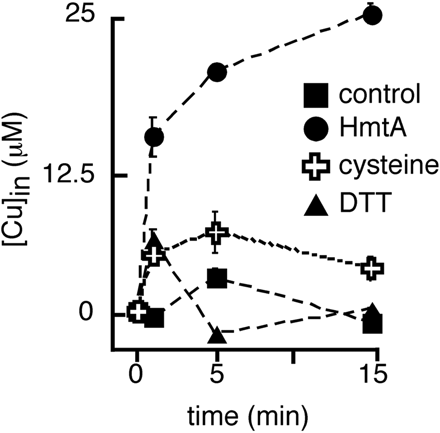Team:Groningen/Project/Transport
From 2009.igem.org
m (→Modelling: Used infoboxes.) |
m (→Modelling: Mentioned changing volumes.) |
||
| Line 92: | Line 92: | ||
# Pasted figure 1B of [[Team:Groningen/Literature#Meng2004|Meng2004]] in a drawing program and aligned/scaled the axes for easier reading of the lines. | # Pasted figure 1B of [[Team:Groningen/Literature#Meng2004|Meng2004]] in a drawing program and aligned/scaled the axes for easier reading of the lines. | ||
| - | # Made [http://spreadsheets.google.com/pub?key=t4gilzCbEaCFAvpEVWUE_zQ a Google Docs spreadsheet] of the wild-type line in figure 1B in [[Team:Groningen/Literature#Meng2004|Meng2004]], converting to units of concentration by using the data in Meng2004 and [http://gchelpdesk.ualberta.ca/CCDB/cgi-bin/STAT_NEW.cgi the CCDB] (assuming that the cells are resting). Specifically (note that uptake is in nmol/mg): | + | # Made [http://spreadsheets.google.com/pub?key=t4gilzCbEaCFAvpEVWUE_zQ a Google Docs spreadsheet] of the wild-type line in figure 1B in [[Team:Groningen/Literature#Meng2004|Meng2004]], converting to units of concentration by using the data in Meng2004 and [http://gchelpdesk.ualberta.ca/CCDB/cgi-bin/STAT_NEW.cgi the CCDB] (assuming that the cells are resting). Here we disregarded the fact that the measurements were made by taking out 0.1mL samples, as this does not change the concentrations. Specifically (note that uptake is in nmol/mg): |
#* uptake<sub>total</sub> (nmol) = uptake · 8mg · 0.3 {{infoBox|0.3 is the ratio between dry and wet weight}} | #* uptake<sub>total</sub> (nmol) = uptake · 8mg · 0.3 {{infoBox|0.3 is the ratio between dry and wet weight}} | ||
#* As(III)<sub>ex</sub> (µM) = (10µM · 10<sup>-3</sup>L - uptake<sub>total</sub> · 10<sup>-3</sup>) / (1.1-0.0073)·10<sup>-3</sup>L {{infoBox|1.1mL is the total volume of the solution and 0.0073 is an estimate of the total cell volume, see below}} | #* As(III)<sub>ex</sub> (µM) = (10µM · 10<sup>-3</sup>L - uptake<sub>total</sub> · 10<sup>-3</sup>) / (1.1-0.0073)·10<sup>-3</sup>L {{infoBox|1.1mL is the total volume of the solution and 0.0073 is an estimate of the total cell volume, see below}} | ||
Revision as of 09:05, 24 July 2009
Introduction
We are trying to find suitable systems capable of isolating heavy metals from the environment. There are several different mechanisms to achieve such a thing. We examined 3 kinds:
- Metal transporters, that transport the metal from the environment (ie. wastewater) to the cytoplasm
- Uncoupled
- Coupled with 'helper' compounds
- Metal binding proteins in the periplasm
We will investigate severals systems, to find which are suitable for the final design. the following systems are under concideration.
- Copper/zinc uptake via HmtA
- heavy metal uptake coupled to citrate via efCitH bsCitM
- Arsenite uptake via GlpF
- Periplasmic accumulation of heavy metals via Mer Operon.
HmtA

HmtA, heavy metal transporter A from Pseudomonas aeruginosa Q9I147 is a P-type ATPase importer. It mediates the uptake of Copper (Cu) and Zinc (Zn) and is functionally expressed in E.coli.
>gi|81857196|sp|Q9I147|Q9I147_PSEAE Probable cation-transporting P-type ATPase
| Enzyme | Number of Sites |
|---|---|
| EcoRI | 0 |
| XbaI | 0 |
| NotI | 0 |
| SpeI | 0 |
| PstI | 2 |
Missing information/To do
- Expression assesment
- Stability
- Level
- Functional assesment
- Uptake speed
- Affinity
- Electrolyte potential generating force
- Eliminate BioBrick restriction sites
Literature
Lewinson O., Lee A.T., Rees D.C. 2009. A P-type ATPase importer that discriminates between essential and toxic transition metals. PNAS. vol. 106, no. 12, p. 4677-4682.
Citrate coupled uptake
Citrate uptake coupled to heavy metals enables forcefeeding of the toxic compounds into the cell when citrate is the only carbound source available. This could be a very effecient strategy to accumelate vass ammounts of heavy metals. The current candidates are CitM from Bacilus subtilis and CitH form Enterococcus faecalis
Missing information/To Do
- Expression assesment
- Stability
- Level
- Functional assesment
- Uptake speed
- Affinity
- Electrolyte potential generating force
- Eliminate BioBrick restriction sites
Literature
Blancato, V.S., Magni, C. & Lolkema, J.S. Functional characterization and Me2+ ion specificity of a Ca2+–citrate transporter from Enterococcus faecalis. FEBS Journal 273, 5121-5130(2006). Bastiaan krom Citrate transporters of Bacilus subtilis Proefschrift. Jessica B. Warner Regulation and expression of the metal citrate transporter CitM Proefschrift.
GlpF
Modelling
The import of As(III) via GlpF is modelled as a simple import reaction with Michaelis-Menten kinetics, in part because this makes it easy to specify in Simbiology, but also because we only have very high level data. To determine the needed constants we performed the following steps:
- Pasted figure 1B of Meng2004 in a drawing program and aligned/scaled the axes for easier reading of the lines.
- Made a Google Docs spreadsheet of the wild-type line in figure 1B in Meng2004, converting to units of concentration by using the data in Meng2004 and the CCDB (assuming that the cells are resting). Here we disregarded the fact that the measurements were made by taking out 0.1mL samples, as this does not change the concentrations. Specifically (note that uptake is in nmol/mg):
- uptaketotal (nmol) = uptake · 8mg · 0.3 0.3 is the ratio between dry and wet weighti
- As(III)ex (µM) = (10µM · 10-3L - uptaketotal · 10-3) / (1.1-0.0073)·10-3L 1.1mL is the total volume of the solution and 0.0073 is an estimate of the total cell volume, see belowi
- uptaketotal (nmol) = uptake · 8mg · 0.3
- Computed the Michaelis-Menten constants in Mathematica (see the Mathematica notebook in SVN) using the method from Goudar1999 (a least squares fit of a closed-form solution of the differential equation).
- Normalized the Vmax parameter by the volume of the cells in suspension. The K parameter need not be changed, as it only depends on the reaction rate constants, not on the concentration of receptors.
The following allows a comparison with the data gotten from figure 1B from Meng2004.
|
Loading graph...
|
Missing information/To Do
- Expression assesment
- Stability
- Level
- Functional assesment
- Uptake speed
- Affinity
- Electrolyte potential generating force
- Eliminate BioBrick restriction sites
- What does the ars operon of our E. coli look like? Do we have both ArsA and ArsB? (And what about ArsR and ArsD?)
Literature
- Meng2004 (As(III) and Sb(III) Uptake by GlpF and Efflux by ArsB in Escherichia coli)
- Rosen2009 (Transport pathways for arsenic and selenium: A minireview)
MerR family
Periplasmic accumulation of heavy metals via Mer proteins enables the harvesting of heavy metals from the medium. By binding the cytosolic and periplasmic metals to metallothionein and transporting the metal-protein complex into the periplasm. The MerR family consists of different proteins for one specific metal. (ie. PbrR(Lead), CueR(Copper), ZntR(Zinc), MerR(Mercury), ArsR(Arsenic), CadR(Cadmium))
As the cells die after uptake of Mg (and induction of the Mer transporter) this system is not very well usable for our project. The dead cells will not produce the gas vesicles (it may be used however by having the gas vesicles consitutively expressed), thereby bouyancy may be a problem.
Missing information/To Do
- Expression assesment
- Stability
- Level
- Functional assesment
- Uptake speed
- Affinity
- Electrolyte potential generating force
- Eliminate BioBrick restriction sites
Literature
Kao, W., Huang, C. & Chang, J. Biosorption of nickel, chromium and zinc by MerP-expressing recombinant Escherichia coli. J. Hazard. Mater 158, 100-106(2008).
Pennella, M.A. & Giedroc, D.P. Structural determinants of metal selectivity in prokaryotic metal-responsive transcriptional regulators. Biometals 18, 413-428(2005).
Planning and requirements:
- Modelling:
- Import speed
- Amount
- Max
- Lab:
- HmtA
- Zn/Cu alone
- B-type ATPase (could be use if there is a ATP shortage?)
- CitM (probably not used)
- Divalent ions
- Citrate around
- Citrate can bind metals that are already bound.
- Measurements (both for the "normal" cell and the cell with overexpression of the transporter)
- Transporter, on/off mechanism, up to what concentration (in the cell) does it still have metal uptake.
- Measure concentration of metal. difference between begin and end concentrations of metal outside the cell.
- How fast does it transport metal in/out the cell.
- HmtA
 "
"
